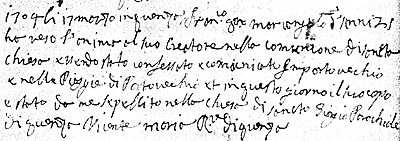Burial records from Quenza, southern CorsicaBurial records, like those for baptism or marriage, follow a formulary. The names and age of the deceased are usually recorded and often the name of near relatives such as father or husband. In some cases place of death is noted but cause is only mentioned if it results in a sudden, unexpected death or a body left unburied. If there is a problem with the burial due to the moral status of the deceased, this may also be mentioned. Because bodies were usually buried on the day following death, these records are a fairly good indication of the biological event. It must however be remembered that this haste, necessary for public health, led to people being buried close to their place of death if this was away from their normal residence. The seasonal migration of the population of Quenza is, for this reason, marked in the burial records, with very few events during the winter months when most people lived in the coastal town of Portovecchio. The recording of the burials of adults is usually good, but those of children, especially infants may be less so. The burial of a child dying before baptism or of a miscarried foetus is hardly ever recorded. As well as the notification of death and the burial itself, the record indicates the ritual state of the deceased in terms of communicant and confessional status, and the sacraments received. Before state regulation and increasing standardisation of cemetery provision in the 19th century choice of burial site was much more varied and symbolically significant. For example, in towns such as Ascoli, the dead could be buried in a a number of different churches, chapels and confraternity shrines. This choice, which is usually listed in the record, provides useful insights into associational life within a town, its main structural divisions, patterns of kinship and support, and in the case of special family tombs, claims to elite status. The first example is the burial of a young man involved in the seasonal migration. He dies and is buried in the mountain village of Quenza, but last received communion and made confession in the coastal winter migratory pole. The Piaggie are the lowland winter pastures, indicating that he is probably a pastoralist.
1704 the 17th March in Quenza, Francesco q Marcangelo aged 21 years returned his soul to his Creator in the communion of the holy church having been confessed and communicated in Portovecchio and in the Piaggie of Portovecchio and on this day his body was buried by me in the church of Santo Giorgio, parish of Quenza. Vincente Maria Rector of Quenza The burial of a young child is usually a much simpler record. There is no mention of communion or confession, as she would not have been confirmed and was therefore unable to take such sacraments.
1717 the 12th February in Quenza 158 Maria Colorinda daughter of Renuccio Ettore of Quenza aged 7 years returned her soul to her Creator in her own house and her body was buried in the church of Santo Giorgio, parish of this place. Sometimes it was not possible for a person to receive the final sacraments, for instance if they died from a sudden accident. In this case the man failed to receive the last rites as he died out in the countryside and is therefore excused them. Problems of distance, such as this are fairly frequent reasons given for this omission.
1717 the 14th February in Quenza 159 Antonio q Giulio of Quenza aged 54 years returned his soul to his Creator in the Communion of the holy church in the countryside without sacraments and his body was buried in the church of Santo Giorgio, parish of this place. Other life event records
|


